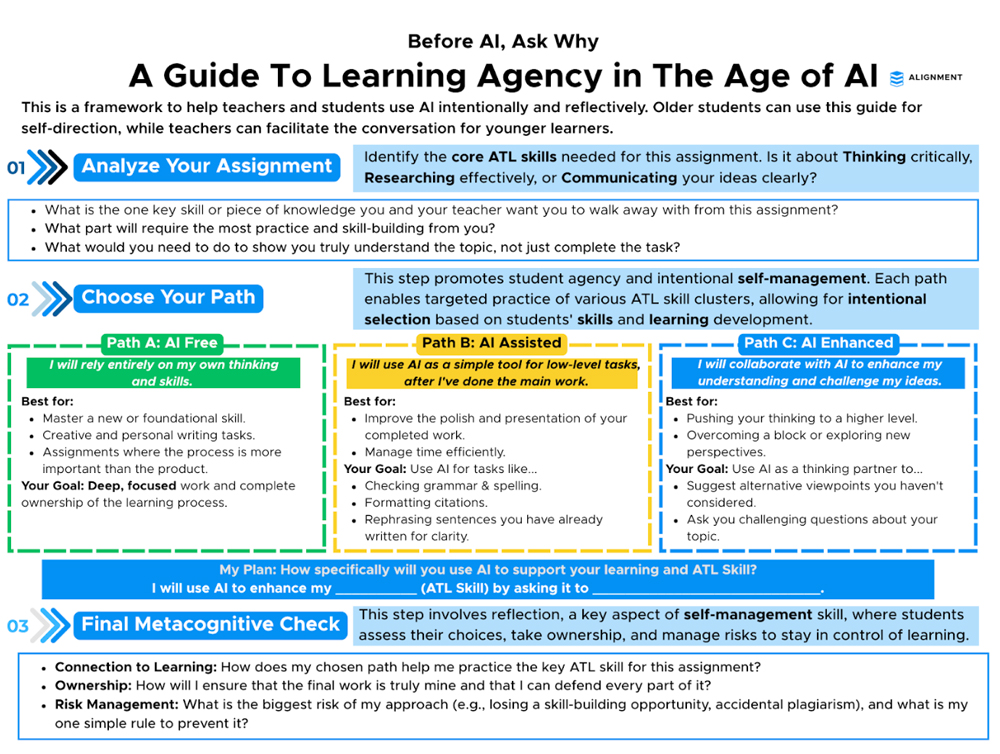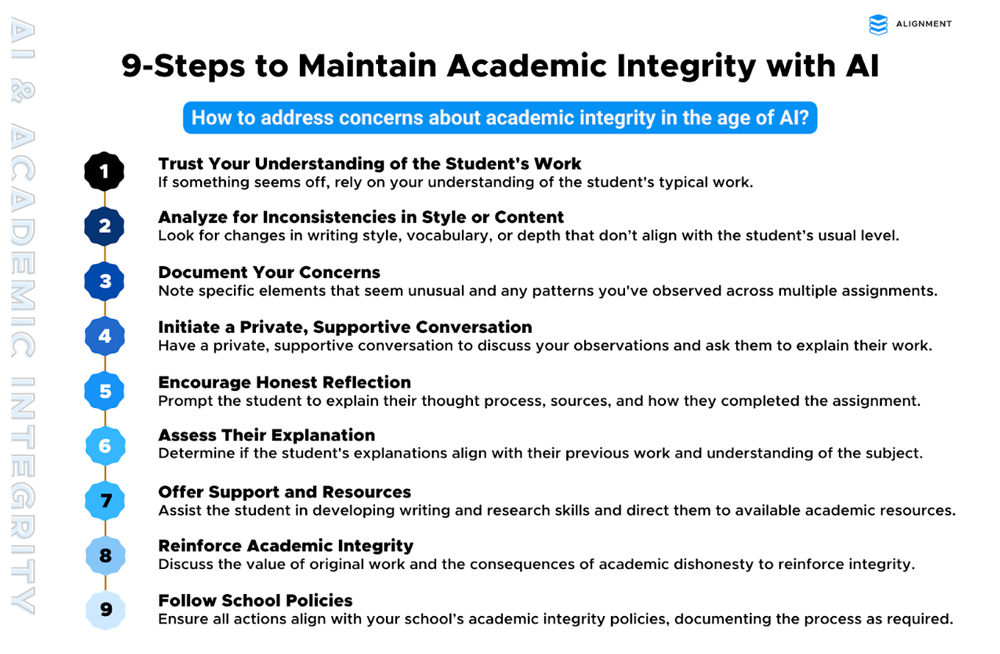
In the last couple of years, we’ve found ourselves in too many meetings with students and our academic director, asking them to explain how they did their work and show us the evidence. Seeing the tears and hearing the arguments in those meetings is always heartbreaking. We sometimes wonder how learning became so fraught with tension and what’s happening behind the scenes. We all know this isn't a new problem, but generative Artificial Intelligence (AI) has made the issue of academic integrity more frequent and more urgent than ever.
AI is an "arrival technology"(Klopfer et al.); it will eventually be embedded in every part of our lives. Simply banning it is not a sustainable solution, especially when our job as educators is to prepare the next generation for the world they will thrive in. It is critical that we teach students how to use AI to enhance their learning, not as a shortcut that allows them to lose the ability to think, learn, and grow.
The reality is, students are already on board. The Digital Education Council’s Global AI Student Survey 2024 (Digital Education Council) indicated that 86% of students use AI in their studies, with 54% using it at least weekly. They often want to learn how to use it effectively, but we can't assume they will just pick up these skills on their own. They need, and deserve, the time and guidance to learn.
When we simply issue top-down bans, we create a disconnect. Students see the power of AI and will use it anyway. But without our guidance, they may use it poorly. Worse, we risk wrongly accusing a student, shattering the trust we’ve worked for years to build. A broken relationship undermines a student’s passion for learning, and that is our greatest concern. This reality creates an urgent need for sustainable, effective approaches to guide students toward authentic learning.
The New Guiding Principle: It's How You Learn, Not What You Learn
With AI, information is more accessible than ever. Students can get answers from the internet or a Large Language Model instantly (whether they are accurate or not). As this technology advances, its accuracy will only improve. Therefore, assessing what students have learned becomes less important than how they learned it.
Instead of focusing only on the final product, we need to pay attention to the learning process. How did a student’s perspective change? What skills did they practice along the way? Understanding this journey helps us see the real skill sets they are developing. Too often, our current education systems only check in at the beginning of an assignment and then evaluate the final outcome. We need to add more checkpoints along the way, creating opportunities for students to showcase their learning evidence and avoiding any blind spots in their development.
Give the Choices Back To Students, Let Them Take the Responsibility
To put this principle into practice, we've developed a framework built around two key guides: one to empower students and another to support educators.
1. Start with "Why": Revisit Learning Objectives
The first step is to bring the purpose of learning back to the center stage. Why does this assignment matter? What, exactly, do we want students to take away from it? Taking the time to discuss this with students helps them understand the purpose behind the work, which in turn promotes their intrinsic motivation.
2. Build a Partnership: Align Expectations and Grant Autonomy
After establishing the "why," the next critical conversation is about the "how." Talk openly with students about the role AI can play in an assignment. Align your expectations and make the guidelines crystal clear so they have a firm direction on what is, and is not, okay.
You can take this a step further by giving them autonomy over their process. We created "A Guide to Owning Your Learning in the Age of AI" to help students choose their own path: AI-Free, AI-Assisted, or AI-Enhanced. This framework encourages them to be intentional. Each path allows for the targeted practice of different skills, empowering students to select the approach that best serves their learning goals. Older students can use this guide for self-direction, while teachers can facilitate the conversation for younger learners.
When students take ownership, they can use AI as a powerful support tool rather than a replacement for thinking. In a recent Hard Fork podcast episode, an MIT student described how she uses an AI tool to break down her assessment topics, find resources, and quiz her until she understands a concept (A.I. School Is in Session). This kind of personalized tutoring was once only available to those who could afford it; now, AI makes it accessible. When we give students opportunities to practice with these tools and the autonomy to learn, they develop proficiency in using these tools to learn.

3. Close the Loop with Reflection
Taking ownership of one’s learning is a process; it won’t be perfect on the first try. That’s why reflection is so important. After an assignment is complete, facilitate a discussion where students can look back on their process and the role AI played in it. This metacognitive check is the final, crucial step in owning their learning journey.

4. Know How to Respond When Concerns Arise
Even with the best framework, there will be times when something feels off. For these situations, we developed a "9-Step Guide to Maintain Academic Integrity with AI." The most important takeaway is to begin any inquiry from a place of support, not accusation.
Growing Alongside Our Students
AI has brought immense change to our classrooms, and while change is never easy, it offers a powerful opportunity to reflect on our practice. The question for us has never been "AI or not AI." Our purpose remains unchanged: to support our students' learning.
This new reality calls on us to shift from being the sole source of knowledge to being the guides who help students master the learning process itself. It reaffirms our focus on how students learn—how they think critically, develop new skills, and navigate their world with integrity. We can embrace this challenge and choose to learn alongside our students, because that is the true meaning of education. We grow together.
References
"A.I. School Is in Session." Hard Fork, The New York Times, 5 Sept. 2025, www.nytimes.com/2025/09/05/podcasts/hardfork-education-alpha-school.html.
Digital Education Council. Global AI Student Survey 2024. 2024. https://www.digitaleducationcouncil.com/post/digital-education-council-global-ai-student-survey-2024
International Baccalaureate. Academic Integrity Policy. https://www.ibo.org/globalassets/new-structure/programmes/shared-resources/pdfs/academic-integrity-policy-en.pdf
Klopfer, Eric, et al. "Generative AI and K-12 Education: An MIT Perspective." An MIT Exploration of Generative AI, 27 Mar. 2024, doi:10.21428/e4baedd9.81164b06.
Cora Yang is a Learning Tech coach at Chinese International School Hong Kong and the co-founder of Alignment Education. She is an educational innovator who believes that technology should serve, celebrate, and elevate the human experience of learning. At her core, she is an educator, driven by a deep commitment to the growth and wellbeing of every student. In her roles, she puts this philosophy into practice. Cora partners with school leadership teams and classroom educators to demystify emerging technologies, particularly Artificial Intelligence. She excels at translating the complexities of AI into practical, actionable strategies that can be implemented school-wide. Her passion and mission are to ensure that innovation is always guided by pedagogy, creating accessible and powerful learning experiences that prepare students for the future with both wisdom and heart.
Dalton Flanagan is the Learning Innovation coach and Innovation Lab coordinator at Chinese International School Hong Kong. In this role, he focuses on bridging the gap between established pedagogy and the future of technology. He is a leader in educational innovation with over a decade of experience spanning Primary Years Programme (PYP), Middle Years Programme (MYP), International General Certificate of Secondary Education (IGCSE), and A-Level frameworks. Dalton’s work is centered on designing authentic learning experiences that embed generative AI tools. Leveraging his deep background in Computer Science and Design, he equips students and fellow educators with the skills to use generative AI tools to deepen inquiry and enhance creativity. As a key voice shaping the conversation around generative AI, he has authored and implemented comprehensive generative AI guidance documents for international schools, establishing frameworks for their strategic and ethical use. He is also the Co-Founder of Alignment Education.
LinkedIn: https://www.linkedin.com/in/dalton-flanagan/